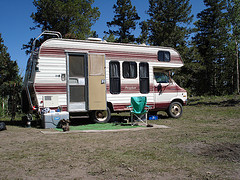
flickr.com/brian_gautreau
At some point in our lives, most of us are struck with wanderlust. Whether you’re itching to travel cross-country or journey across the continent, a motor home is the best way to cruise in comfort and style.
For years, adventurous trekkers have used motor homes to travel wherever their dreams take them. One reason for the motor home’s enduring popularity is in its ability to carry a large group of people. Entire families can pack all their gear and take off on road trips, without sacrificing the amenities, comforts and privacy of home.
Motor homes are commonly known as RVs, or recreational vehicles. As the name implies, motor homes are excellent choices for recreational travel. These motels on wheels were originally designed by Winnebago Industries, a company that has dominated the market for many years by providing groups and families with portable living quarters for camping, travel and other recreational uses.
Unlike traditional trailers, motor homes are self-contained vehicles with an engine and a permanently attached motor vehicle chassis.
Motor homes generally fall under three major categories: Class A, Class B and Class C motor homes. Consider these factors when choosing the best model for your needs:
Class A Motor Coach — A motor home given the “Class A” distinction is recognized as a medium to large van that is completely coach built. The term “coach built” refers to a vehicle that has nothing of the original van bodywork or cab exterior. This may be constructed on a truck chassis that is used commercially, a commercial bus chassis, or a chassis specifically designed for motor vehicles. Class A motor homes are usually sized from 26 to 45 feet.
Class B Camper Van — This type of motor home is designed and built with the use of a conventional van. It can often be identified by a raised roof that has been added to the van. The Class B Camper Van may also feature a low profile rear body, and is therefore sometimes referred to as a “low profile motor home”. In terms of size, Class B motor homes may range in size from 19 to 24 feet.
Class C Motor Home — This third class is usually built on a truck chassis. There is an attached cab portion, usually van based. The Class C motor home may also be built on pickup truck or even a larger freightliner truck. The size can vary from 17 to 34 feet.
Regardless of the class of motor home you choose, most are generally easy to drive. At least, that’s what most motor home drivers have claimed. Motor homes usually have power steering for easy driving and maneuverability. Once the steering is adjusted to your unique size and stature, it’s smooth sailing ahead.
If the call of the open road beckons you, visit a motor home dealer and see which of these vacation-on-wheels suits you best.
Tagged with: mobile home • motor home
Filed under: Family Vacation